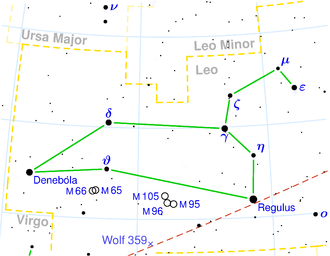NGC 3828
| Galaxy NGC 3828 |
|
|---|---|

|
|
| SDSS recording | |
| AladinLite | |
| Constellation | lion |
|
Position equinox : J2000.0 , epoch : J2000.0 |
|
| Right ascension | 11 h 42 m 58.4 s |
| declination | + 16 ° 29 ′ 15 ″ |
| Appearance | |
| Morphological type | S / LINER |
| Brightness (visual) | 14.8 mag |
| Brightness (B-band) | 15.6 mag |
| Angular expansion | 0.8 ′ × 0.5 ′ |
| Position angle | 30 ° |
| Surface brightness | 13.7 mag / arcmin² |
| Physical data | |
| Redshift | 0.034510 ± 0.000090 |
| Radial velocity | 10,346 ± 27 km / s |
|
Stroke distance v rad / H 0 |
(460 ± 32) · 10 6 ly (140.9 ± 9.9) Mpc |
| history | |
| discovery | Guillaume Bigourdan |
| Discovery date | March 28, 1886 |
| Catalog names | |
| NGC 3828 • PGC 36376 • CGCG 097-075 • MCG + 03-30-057 • 2MASX J11425845 + 1629151 • GALEX ASC J114258.44 + 162914.0 • NSA 113265 | |
NGC 3828 is a spiral galaxy with an active nucleus of the Hubble type S in the constellation Leo on the ecliptic . It is estimated to be 460 million light years away from the Milky Way and has a diameter of around 110,000 ly.
In the same area of the sky is the galaxy NGC 3853 .
The object was discovered by Guillaume Bigourdan on March 28, 1886 .
Web links
Commons : NGC 3828 - collection of images, videos, and audio files
